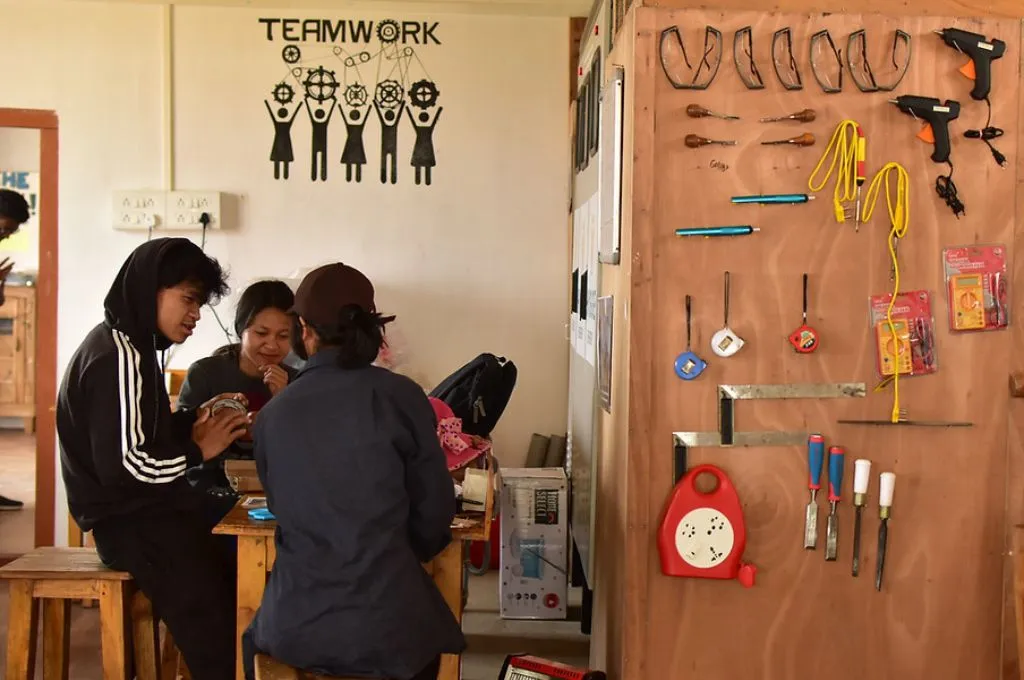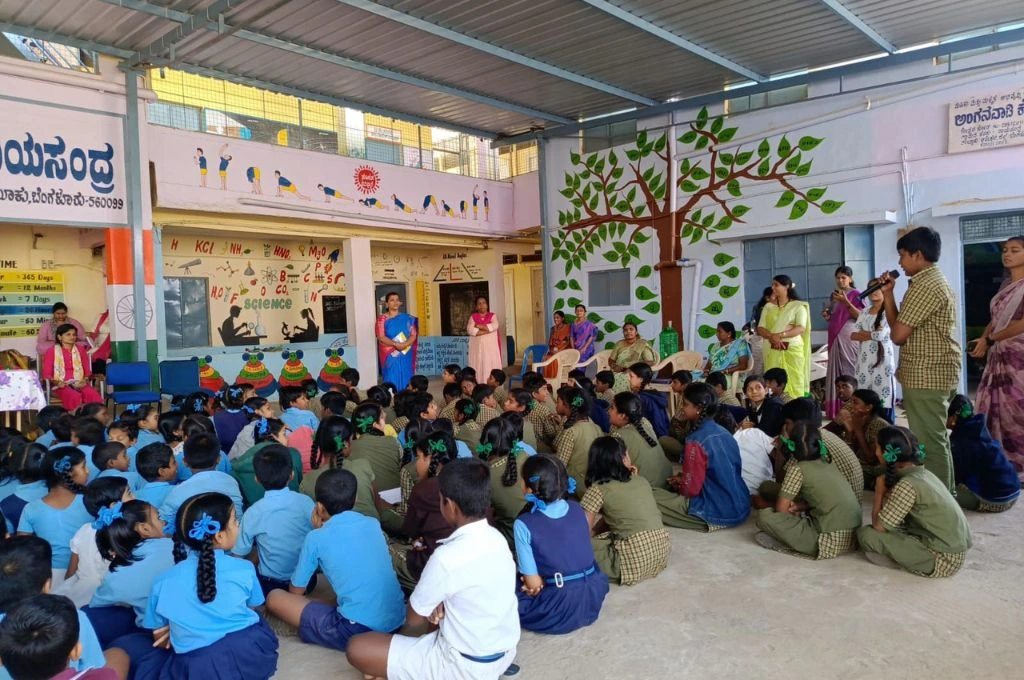As India accelerates towards becoming the third largest global economy, its growth is marked by increasing inequality. The post-pandemic recovery has been uneven and characterised by a K-shaped growth trajectory, where certain segments of the population experience rapid growth while others face economic decline. Governments must establish robust socio-economic safety nets to ensure inclusive and equitable growth. This responsibility is not only a moral imperative but also a constitutional duty and obligation of the Indian state.
The implementation of comprehensive welfare programmes, targeted subsidies, and improved access to essential services such as quality healthcare and education are crucial for promoting social justice and ensuring that the benefits of economic growth are distributed equitably.
Union Budgets serve as a critical indicator of the government’s intentions, priorities, and policy objectives. They not only shape the economic and social landscape of the country but also provide insight into the nation’s governance.
Over the past decade, the Union Government has positioned itself as a champion of welfare. However, decreasing allocations to crucial sectors such as food, social security, health, and education in recent budgets make this claim hard to defend. Despite the finance minister’s announcement to focus on the ‘gareeb’, or the poor, the Union Budget 2024–25 continues with a decade-long trend of reduced allocations, further weakening the government’s stance as a welfare advocate.
The right to food
The guarantee of access to safe and nutritious food is foundational to the concept of the right to a dignified life. The right to food, enshrined as a fundamental right under Article 21 of the Constitution of India, extends beyond merely guaranteeing freedom from hunger and includes nutritional security. This right is implemented through the various schemes under the National Food Security Act (NFSA), 2013. However, nearly a decade after the implementation of the NFSA, India continues to struggle with high levels of hunger and undernourishment. At a level of hunger described as ‘serious’ by the Global Hunger Index (GHI), India is currently undergoing a massive food and nutritional crisis, which has only been exacerbated by the COVID-19 pandemic. A 2024 UN Report on food security found that at 194.6 million, India has the highest undernourished population in the world.
Despite this, allocations to the different programmes under NFSA have seen a steady decrease since before 2019. The share of the budgeted expenditure for food subsidy distributed through the public distribution system (PDS) has declined from 6.61 percent in 2019–20 to 4.25 percent in the present budget. Even with the additional food grains provided under the more recently launched Pradhan Mantri Garib Kalyan Anna Yojana, allocations for food subsidies remain lower than pre-pandemic levels. Economists argue that this is especially concerning, because with the excess buffer stocks in possession of the Food Corporation of India, India can not only continue to provide surplus food grains but also has the capacity to universalise the PDS. Doing so would help overcome the large-scale exclusions caused by outdated PDS lists, stringent eligibility criteria, and technological barriers, which currently prevent crores of individuals from accessing food grains they are entitled to.
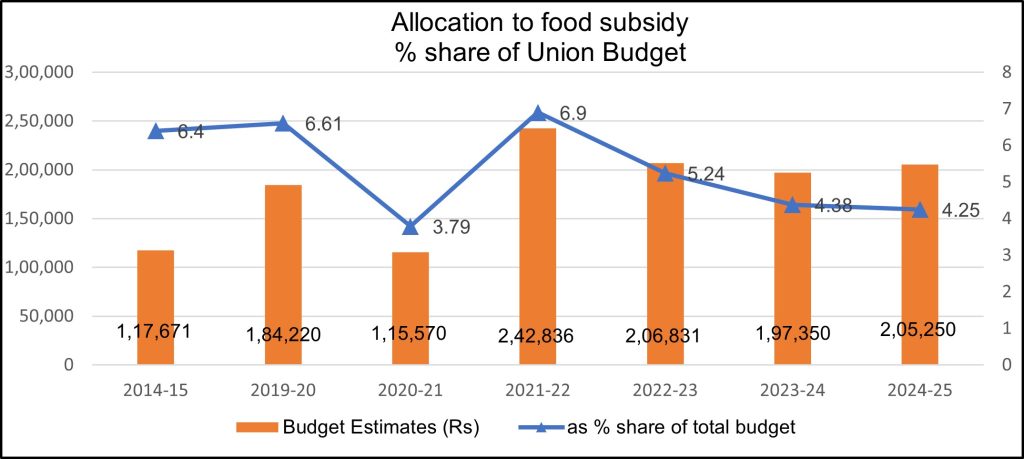
Experts emphasise that the PDS basket needs to be expanded to include pulses and edible oils in order to reach nutritional security. In the context of the growing inflation and rising prices of essential commodities this becomes particularly important.1
While basic food security for individuals is met through the PDS, other important schemes under the NFSA aim to improve the nutritional and health standards of children and women. These include the Integrated Child Development Services (ICDS) (which merged Saksham Anganwadi and POSHAN 2.0 along with other schemes in 2021-22), the maternity benefit scheme known as the Pradhan Mantri Matru Vandana Yojana (PMMVY) (subsumed under the Samarthya umbrella in 2022), and the Mid-Day Meal scheme (MDM) (renamed PM Poshan). Despite having some of the highest rates of child wasting, stunting, and undernourishment in the world, budget allocations to these crucial schemes have steadily declined as a proportion of the overall budget. With INR 12,467 crore allocated to PM Poshan, the scheme’s share of the budget has remained constant since FY 2022-23, down from 0.39% in 2019-20. Following the merger of ICDS and PMMVY into the Saksham Anganwadi and POSHAN 2.0 and the Samarthya programmes, the budget for these schemes has been significantly reduced. In 2013-14, ICDS alone accounted for 0.95 percent of the budget, but this has dropped to 0.43 percent in the current budget since the merger. Additionally, no disaggregated information is available for these schemes post-merger.

Socio-economic protection for the most vulnerable
Key socio-economic protection schemes run by the Ministry of Rural Development—the Mahatma Gandhi National Rural Guarantee Scheme (MGNREGS) and the National Social Assistance Programme (NSAP)—have also seen only minimal increases in their allocated budgets. While the budget for MGNREGS has increased from INR 60,000 crore in 2023–24 to INR 86,000 crore in 2024–25, approximately 20 percent of the current allocation is put towards clearing pending dues from the previous fiscal year. LibTech India calculated that, as of April 2024, funds for MGNREGS ran into a negative balance of INR 20,751 crore. If this amount is adjusted in the allocations for the current budget, MGNREGS’ share in the budget reduces from 1.78 percent to 1.35 percent. Even though the Union Budget 2024–25 focuses entirely on employment generation, it appears to have overlooked the need for adequate allocations for the 13.08 crore active workers currently enrolled under the scheme. A huge shortfall in funding, along with numerous issues such as job card deletion, the Aadhaar-based payment system, and poorly designed technological interventions continuously undermine the functioning of the scheme.
The budget allocation for the NSAP, which offers non-contributory pension support to the elderly, widows, and individuals with disabilities, has risen to INR 9,652 crore; this is an increase of INR 16 crore from the previous year’s budget estimates. However, when adjusted for inflation, this too represents a decline.
The India Ageing Report 2023 estimates that at present, approximately 6 crore elderly people fall into the poorest wealth quintile. Only 2.21 crore senior citizens are currently enrolled under the NSAP. The monthly pension disbursed by the Union Government has remained stagnant at INR 200 for the elderly (since 2007) and INR 300 for women and persons with disabilities (since 2011). State governments are covering the shortfall by paying approximately to five to 10 times more from their own budgets to ensure adequate pension amounts. Additionally, the failure to conduct a new census has led many welfare schemes—including the NSAP, PDS, and Ayushman Bharat Pradhan Mantri Jan Arogya Yojana (PMJAY)—to rely on outdated data from the 2011 socio-economic and caste census to determine ‘beneficiary’ eligibility, leading to widespread exclusion of many who are marginalised and vulnerable.
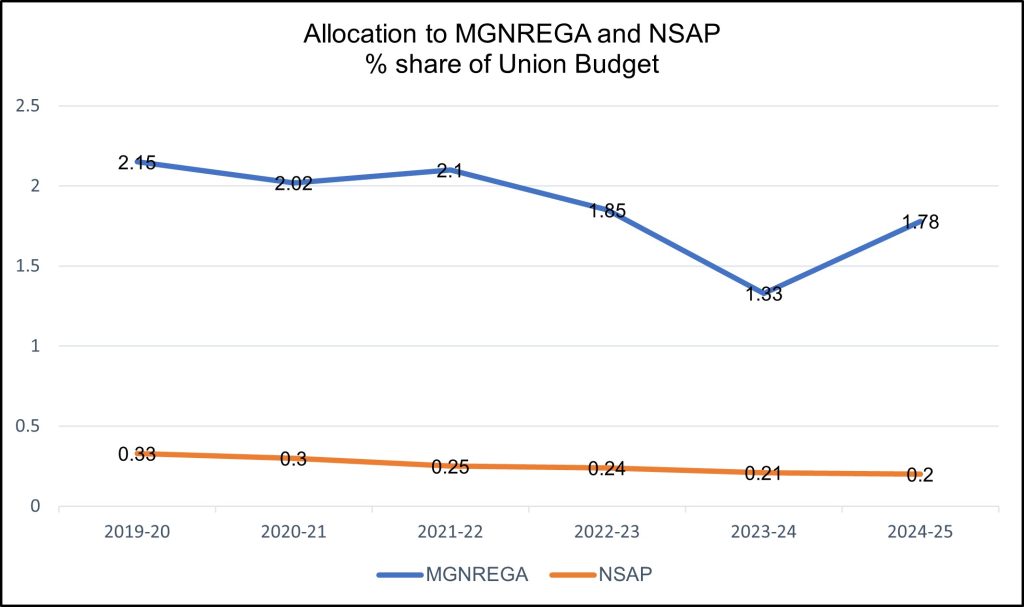
Education: An increasingly privatised right
Allocations to the Department of School Education and Literacy and the Department of Higher Education have increased by INR 4,203 crore and INR 3,525 crore respectively. The combined allocation to the Ministry of Education in the 2024–25 budget stands at INR 1,20,628 crore; this accounts for 2.5 percent of the total budget and 0.37 percent of India’s GDP. The National Education Policy (NEP) 2020 recommends that the education budget should be at least 6 percent of the GDP. Investment in education is essential for the sustainable growth of any developing economy. Despite the increase in allocations to the Ministry of Education, its share of the overall budget has consistently decline over the past ten years. The condition of school and higher education in India remains deeply concerning. According to UDISE+ data, the push towards the privatisation of education has resulted in the closure of 61,923 government-aided schools as well as schools run by the central and state governments between 2014–15 and 2021–22, while the number of private schools has increased by 47,680. An increase in privatisation not only worsens barriers to access but also reinforces social hierarchies of caste, class, and gender. Further, the ‘school rationalisation’ policy recommended by the NEP led to the closure and merger of at least 50,000 schools across the country in 2023.2 The merging of schools, especially in geographically remote areas, hinders access to education and is a violation of the Right to Education Act. This practice increases the challenges faced by communities already grappling with limited educational infrastructure and enhances inequalities in access to education and opportunities. Additionally, findings from the 2023 Annual Status of Education Report on the quality of rural education points to serious structural issues within the education system. The report states that a sizeable proportion of children has progressed through the school system without having acquired foundational mathematical and reading abilities. The massive shortage of teachers and human resources at both the school and higher education levels only exacerbate the issue further.3

The budget for the Department of Higher Education has seen an increase in allocations for programmes related to skill development and training, while the money for the University Grants Commission (UGC), which support public universities, has been slashed by approximately 50 percent. However, the government’s focus on skilling programmes is not new. Since 2015, the Union Government has invested in skill building and training programmes such as Skill India. Despite this, data from the Period Labour Force Participation Survey (PLFS) suggests that these programmes have not resulted in meaningful employment generation, as both rural and urban diploma holders continue to face high levels of unemployment. The overall higher education budget is INR 47,620 crores, which is INR 9,625 crores less than the revised estimates of the previous year. The proportion of the budget allocated to higher education has decreased from 1.37 percent in 2019–20 to 0.98 percent in 2024–25.
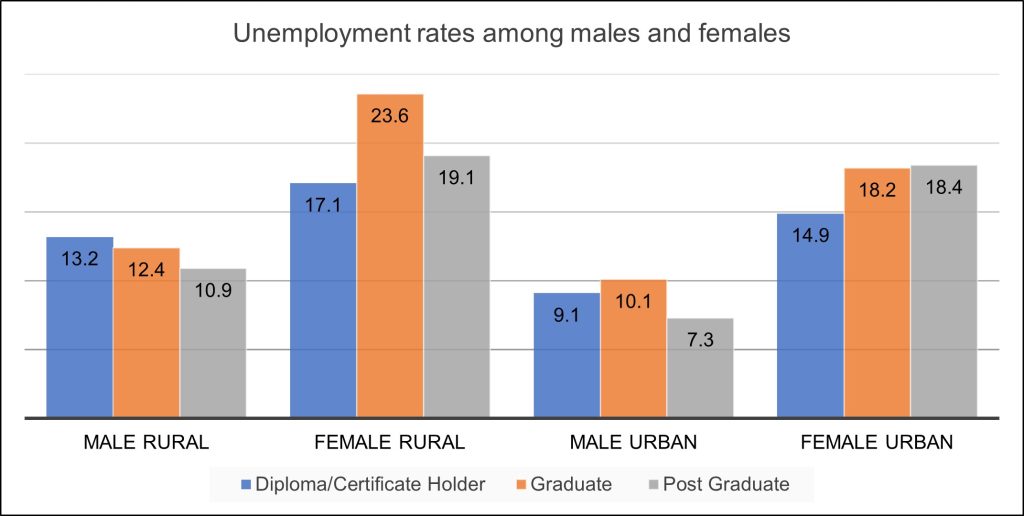
Reduced access to healthcare
Despite the significant gaps in India’s healthcare system exposed by COVID-19, the allocation to the Ministry of Health has gradually declined from 2.16 percent of the budget in 2019–20 to 1.88 percent in the 2024–25 budget. Although the National Health Policy sets a target of 2.5 percent of GDP for healthcare spending, the current budget allocation is only 0.27 percent of GDP. Instead of increasing investments to enhance primary health services, which serve as the first access point for economically marginalised and rural populations, the government has continued to allocate more funds to tertiary-level health services and infrastructure.

The share of allocations to the National Health Mission (NHM) decreased from 1.2 percent in 2019-20 to 0.74 percent in the current budget. Data from the National Family Health Survey (NFHS)-5 reveals that approximately 60 percent of women in India cannot access affordable health services due to inadequate infrastructure and a shortage of healthcare workers. According to NFHS-5, 40.4 percent of women reported being unable to access medicines, and 39.2 percent could not reach healthcare providers. In addition, 31.2 percent stated that there were no female service providers at health centres. NHM is vital to providing equitable and affordable healthcare, so diminishing funding threatens healthcare accessibility for vulnerable populations.
In contrast, budget allocations for PM-JAY—the NDA government’s flagship programme which provides health insurance coverage for secondary and tertiary care hospitalisation—have continued to increase even as actual spending remains low. From 2019–20 to 2022–23, an average of INR 3,796 crore was spent annually, compared to an average allocation of INR 6,403 crore for the scheme.
During the first three years (2018–21) of the scheme, 1.25 Ayushman cards were issued and 20,387 hospitals were empanelled. However, while an approximate 20 crore cards were issued over the next two and a half years (2022–July 2024), the number of empanelled hospitals only increased by 9,372. A 2023 CAG report found that the availability of empanelled health care providers (EHCPs) per lakh ‘beneficiaries’ in many states was low. It also noted that hospitals in several states lacked adequate infrastructure and equipment and faced human resource shortages. With low actual spending and poor quality of infrastructure and services, the focus of the government has been to boast of impressive enrolment numbers rather than improving availability and quality of services. Moreover, of the total 30,285 hospitals offering services under PM-JAY, 43.73 percent are private, which also leads to increased healthcare costs. To effectively address the needs of the increasing number of people being enrolled in the scheme, the government must also provide adequate infrastructure.
Overall, while building a robust system for tertiary healthcare is necessary, addressing health needs at the primary level allows governments to improve overall health outcomes and reduce healthcare costs.
A declining welfare state
Ultimately, the Union Budget 2024–25 fails to address India’s pressing socio-economic challenges. Despite the government’s rhetoric on welfare, budget allocations for essential social sectors continue to decline. A significant shift in budgetary priorities towards social sector spending is imperative. Increased investments in these sectors are not just economically desirable but are also essential to fulfilling the constitutional promise of social justice. The constraints on budgets seriously undermine this fundamental obligation, leaving the most vulnerable further marginalised and neglected.
—
Footnotes:
- As per data available with the Price Monitoring Division, Ministry of Consumer Affairs, between 2014 and 2023, the price of groundnut oil increased by 58.04 percent and that of mustard oil by 41.61 percent.
- The NEP proposes the process of school rationalisation, which involves the consolidation of existing institutions, to enhance effective school governance.
- According to a 2023 Parliamentary Standing Committee Report, out of the sanctioned 62.71 lakh teacher positions at the state level, 9.9 lakh posts remain vacant. These include 7.5 lakh unfilled positions at the primary level, 1.6 lakh vacancies at the secondary level, and 92,000 vacancies at the higher secondary level. In addition, out of a total 18,956 teaching positions across 45 central universities, approximately 33 percent (or 6,180) posts are currently vacant.
—




